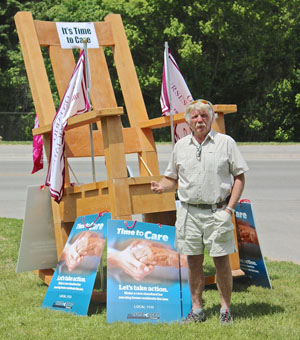Headline News » News
Sitting tall for long-term care
June 23, 2016

Ontario Health Coalition volunteer Peter Voyle explains the current issues facing the aging population.
By Sarah Sobanski
Members of the Ontario Health Coalition (OHC) took a moment to rock outside of the Hastings Centennial Manor last week – but not in the musical way.
Local nursing staff and union members, resident family council members and volunteers erected a 10-foot tall rocking chair to encourage quality long-term care advocacy within Bancroft. They want community members to contact their MPPs and demand that a minimum standard of care be legislated for long-term care residents. They also want long-term facilities to become more accessible.
“Twenty years ago there were minimum standards of care. They were two and a half hours [per resident]. The Harris government wiped all those standards of care out, so there aren’t legislative standards of care in long-term care homes,” explained OHC volunteer Peter Voyle.
“Studies done from as far back as 15 years ago, so this is old data, say that the minimum standard should be at least four hours per patient on average.”
Voyle added, “That was based on the acuity diseases back then for how much help and medical care they needed. Since then, people have been living longer and suffering more debilitating diseases such as dementia and Alzheimer’s.”
Over 80,000 people reside in long-term care homes across Ontario. An additional 20,000 or so people are waiting for access to a residency. At any given time over 20 per cent of those who can no longer be taken care of within their own homes are forced to remain in family care until a spot becomes available.
“Right now, we have the war generation which mostly populates long-term care homes in Ontario, and we have the baby boomers coming up,” said Voyle. “The boomers that are coming forward are 10 times bigger than our war generation.”
Lack of funding for long-term care facilities and staff has resulted in caretakers fulfilling patient needs on a basic level only.
“Oftentimes, the quality of care suffers because of a lack of time. Staff at long-term care homes are spread so thin. They’re so dedicated to meeting the basic needs of their patients, that they can’t spend the extra time to make those truly intimate and personal connections with their patients and residents,” said Jackie Dales, coordinator for Local 31 of the Ontario Nurses Association. “Anyone who goes into this field knows that that’s why you do it, because you have a passion for caring for people who are in their final days.”
Almost 65 per cent of long-term care residents suffer from dementia related diseases, including Alzheimer’s, and half of residents have aggressive behaviours. Small staffing numbers, where nurses cannot dedicate enough time to those in need, allow dangerous and violent situations to flourish.
Since 2001, 24 long-term care residents have died as a result of violence from other residents. The OHC suggests thousands of residents have been attacked by other violent residents.
“The rocking chair is a symbol of care. I was rocked in one by my mother and grandmother when I was a baby living on a farm,” said Voyle. “It’s a sign of comfort in your golden years but unfortunately that’s not the case today in long-term care homes.”
This is the third year that the OHC has travelled with the giant rocking chair to garner support. Its 15 pieces are held together by locking mechanisms and eight screws. This year the chair will tour 19 communities across Ontario.
The coalition is aiming to collect 20,000 signatures petitioning for minimum standards of care for long-term care residents. This number represents the some 20,000 people waiting to be placed in homes.
“With long waiting lists, you might get a long-term care bed offer within a few months of applying for a bed, but it might not be in the community that you’ve lived in for your entire life,” said Dales. “We have patients, and have had patients over the years, in Stirling, that have come from Bancroft and have had to wait for a bed in Bancroft for a very long time before they can be cared for in our community. You should be having care in the community of your choice.”
For those who are looking to get involved further, resident family councils are always looking for members and support.
Tom Carrothers, chair of the advocacy committee for Family Council Network 4 (FCN-4), noted that while most family council members join because they have a family member in long-term care, members who have lost a loved one are encouraged to join or stay on after their loved one has passed.
“You’re probably with a network of a million or so people if every resident has a network of 10 people, between their sons and daughters, and their sons’ and daughters’ friends,” said Carrothers. “Why can’t we get a million people telling MPPs they have to change? That’s what has to happen, MPPs have to be made aware that it’s an issue, and it’s an issue that they may get re-elected on.”
More information on the FCN-4 letter campaign and petition for long-term care rights can be found at www.fco.ngo/updates-and-events/updates/family-council-network-4-letter-writing-campaign.
“We’re trying to get people to say hey, is this a way to treat our elders? No, it’s not. We’re all heading there at some point,” said Voyle.

















